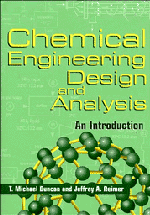Book contents
- Frontmatter
- Contents
- Preface
- Acknowledgments
- 1 An Overview of Chemical Engineering
- 2 Process Design
- 3 Models Derived from Laws and Mathematical Analysis
- 4 Graphical Analysis
- 5 Dimensional Analysis and Dynamic Scaling
- 6 Transient Processes
- Appendix A List of Symbols
- Appendix B Units, Conversion Factors, and Physical Constants
- Appendix C Significant Figures
- Appendix D Graph Paper
- Appendix E Mathematics, Mechanics, and Thermodynamics
- Appendix F Glossary of Chemical Engineering
- Index
1 - An Overview of Chemical Engineering
- Frontmatter
- Contents
- Preface
- Acknowledgments
- 1 An Overview of Chemical Engineering
- 2 Process Design
- 3 Models Derived from Laws and Mathematical Analysis
- 4 Graphical Analysis
- 5 Dimensional Analysis and Dynamic Scaling
- 6 Transient Processes
- Appendix A List of Symbols
- Appendix B Units, Conversion Factors, and Physical Constants
- Appendix C Significant Figures
- Appendix D Graph Paper
- Appendix E Mathematics, Mechanics, and Thermodynamics
- Appendix F Glossary of Chemical Engineering
- Index
Summary
THIS TEXTBOOK has two goals. The first is to describe the chemical engineering profession. We will use contemporary applications of chemical engineering to introduce fundamental concepts. The applications include case studies and chemical processes from the technical literature and the popular press. The second goal is to introduce and develop basic engineering skills. Chief among these skills are design – the ability to conceive and develop plans – and analysis – the methodology to model and evaluate chemical and physical processes.
Some of the concepts introduced in this text are complex and usually require an entire course and its prerequisites to appreciate fully. You must be willing, therefore, to set aside questions about the basis for certain material or the origins of certain equations or relationships. We will, however, attempt to provide at least a heuristic description of the material's origin and point to where in the chemical engineering curriculum the material is discussed in more detail.
Finally, in this text we attempt to appeal to a variety of learning and thinking styles. We appreciate that not all students prefer to think globally, reason deductively, or perceive visually. In each of the exercise sets we have attempted to invoke different styles of learning to make learning chemical engineering as inclusive as possible.
Chemical Engineering
Chemical engineers create processes based upon physical and chemical change. The processes may yield marketable items, such as gasoline or penicillin, or noncommercial items, such as clean air or clean water.
- Type
- Chapter
- Information
- Chemical Engineering Design and AnalysisAn Introduction, pp. 1 - 6Publisher: Cambridge University PressPrint publication year: 1998



